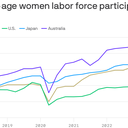There are more women in the global workforce now than before COVID

The share of women in the workforce is far exceeding pre-pandemic levels around the globe.
Why it matters: Women have made a triumphant comeback into the workforce after the shock of COVID — defying doomsday predictions.
- More women working is good for the economy, especially in a tight labor market — and good for women, too.
Zoom in: Labor force participation rates — the share who are either working or looking for work — among working-age women has blown past pre-pandemic levels in the U.S., the E.U., Japan, Australia, and in most major Asian and Latin American countries, according to data in a new report from Moody's.
- Rates for men have not increased at the same pace.
The big picture: Tighter labor markets have pulled more workers off the sidelines, and since women's workforce participation is generally much lower than men's — there was more room to grow.
- Remote work and hybrid schedules have also drawn more women into the workforce. In most countries, women typically handle more caregiving responsibilities, and making work more flexible enables them to juggle both worlds.
- Finally, Moody's cites the rising cost of living across the globe after high inflation and interest rates put pressure on household budgets. Families went looking for more money — particularly single-income households.
Reality check: Men are still working at higher rates in every country Moody's examined.
- That's partly because women are working in (unpaid) ways that don't show up in the official government data — caring for children or elders.
- The women's participation rate in the U.S. is low compared to its peer countries (look at the chart up top), thanks to a lack of affordable child care options, as well as paid parental and family leave.
What to watch: There are signs in the U.S. that these higher rates may wobble.
- The increased cost of child care — up 32% in 2023 from the 2019 average — may be pushing some women out of the workforce, according to research last month from the Bank of America Institute.
The bottom line: Happy Women's History Month.